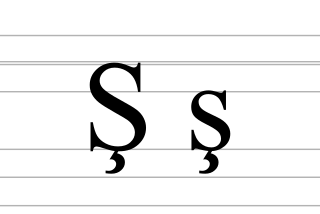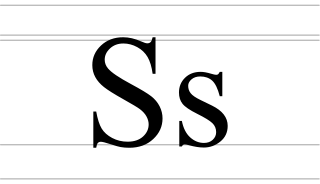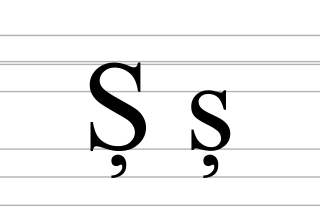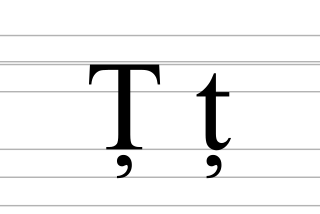
A diacritic is a glyph added to a letter or to a basic glyph. The term derives from the Ancient Greek διακριτικός, from διακρίνω. The word diacritic is a noun, though it is sometimes used in an attributive sense, whereas diacritical is only an adjective. Some diacritics, such as the acute ⟨ó⟩, grave ⟨ò⟩, and circumflex ⟨ô⟩, are often called accents. Diacritics may appear above or below a letter or in some other position such as within the letter or between two letters.

QWERTY is a keyboard layout for Latin-script alphabets. The name comes from the order of the first six keys on the top letter row of the keyboard: QWERTY. The QWERTY design is based on a layout included in the Sholes and Glidden typewriter sold via E. Remington and Sons from 1874. QWERTY became popular with the success of the Remington No. 2 of 1878 and remains in ubiquitous use.
The comma, is a punctuation mark that appears in several variants in different languages. Some typefaces render it as a small line, slightly curved or straight, but inclined from the vertical, others give it the appearance of a miniature filled-in figure 9 placed on the baseline. In many typefaces it is the same shape as an apostrophe or single closing quotation mark ’.
A cedilla, or cedille, is a hook or tail added under certain letters to indicate that their pronunciation is modified. In Catalan, French, and Portuguese it is used only under the letter ⟨c⟩, and the entire letter is called, respectively, c trencada, c cédille, and c cedilhado. It is used to mark vowel nasalization in many languages of Sub-Saharan Africa, including Vute from Cameroon.

Ç or ç (C-cedilla) is a Latin script letter used in the Albanian, Azerbaijani, Manx, Tatar, Turkish, Turkmen, Kurdish, Kazakh, and Romance alphabets. Romance languages that use this letter include Catalan, French, Portuguese, and Occitan, as a variant of the letter C with a cedilla. It is also occasionally used in Crimean Tatar and in Tajik to represent the sound. It is rarely used in Balinese, usually only in the word "Çaka" during Nyepi, one of the Balinese Hinduism holidays. It is often retained in the spelling of loanwords from any of these languages in English, Basque, Dutch, Spanish and other languages using the Latin alphabet.

S-cedilla is a letter used in some of the Turkic languages. It occurs in the Azerbaijani, Gagauz, Turkish, and Turkmen alphabets. It is also planned to be in the Latin-based Kazakh alphabet. It is used in Brahui, Chechen, Crimean Tatar, Kurdish, and Tatar as well, when they are written in the Latin alphabet.

The QWERTZQWERTZU, or QWERTZUIOP keyboard is a typewriter and keyboard layout widely used in Central and Southeast Europe. The name comes from the first six letters at the top left of the keyboard:.

The Romanian alphabet is a variant of the Latin alphabet used for writing the Romanian language. It is a modification of the classical Latin alphabet and consists of 31 letters, five of which have been modified from their Latin originals for the phonetic requirements of the language.

Tse, also known as Ce, is a letter of the Cyrillic script.

Dze is a letter of the Cyrillic script, used in the Macedonian alphabet to represent the voiced alveolar affricate, similar to the pronunciation of ⟨ds⟩ in "needs" or "kids" in English. It is derived from the letter dzelo or zelo of the Early Cyrillic alphabet, and it was used historically in all Slavic languages that use Cyrillic.

S-comma is a letter which is part of the Romanian alphabet, used to represent the sound, the voiceless postalveolar fricative. S-comma consists of an s with a diacritical comma underneath it, and is distinct from s-cedilla.
The Common Turkic alphabet is a project of a single Latin alphabet for all Turkic languages based on a slightly modified Turkish alphabet, with 34 letters recognised by the Organization of Turkic States.

T-comma is a letter which consists of a t with a diacritical comma underneath it, and is distinct from t-cedilla. It is part of the Romanian alphabet, used to represent the Romanian language sound, the voiceless alveolar affricate. The letter is also a part of the Finno-Ugric Livonian language alphabet, representing the sound.
The modern Gagauz alphabet is a 31-letter Latin-based alphabet modelled on the Turkish alphabet and Azerbaijani. It is used to write the Gagauz language.
T.51 / ISO/IEC 6937:2001, Information technology — Coded graphic character set for text communication — Latin alphabet, is a multibyte extension of ASCII, or more precisely ISO/IEC 646-IRV. It was developed in common with ITU-T for telematic services under the name of T.51, and first became an ISO standard in 1983. Certain byte codes are used as lead bytes for letters with diacritics. The value of the lead byte often indicates which diacritic that the letter has, and the follow byte then has the ASCII-value for the letter that the diacritic is on.

T-cedilla is a letter which is part of the Gagauz alphabet, used to represent the sound, the voiceless alveolar affricate. It is written as the letter T with a cedilla below and it has both the lower-case (U+0163) and the upper-case variants (U+0162). It is also used in the Manjak and Mankanya language for.

Te with descender is a letter of the Cyrillic script. Its form is derived from the Cyrillic letter Te by the addition of a descender to the leg of the letter.

D-comma is a letter that was part of the Romanian alphabet to represent the sound or if it was derived from a Latin d. It was the equivalent of the Cyrillic letters З and Ѕ.
Latin Extended-B is the fourth block (0180-024F) of the Unicode Standard. It has been included since version 1.0, where it was only allocated to the code points 0180-01FF and contained 113 characters. During unification with ISO 10646 for version 1.1, the block range was extended by 80 code points and another 35 characters were assigned. In version 3.0 and later, the last 60 available code points in the block were assigned. Its block name in Unicode 1.0 was Extended Latin.

The current Romanian National Standard SR 13392:2004 establishes two layouts for Romanian keyboards: a "primary" one and a "secondary" one.














